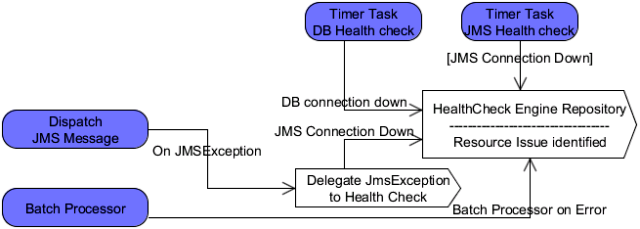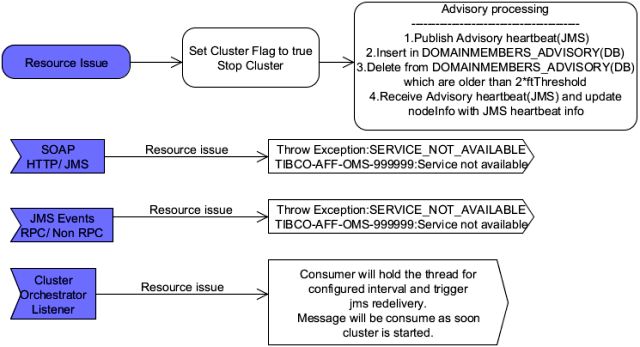Resource Failure Handling
The Resource Failure Handling feature identifies the failure or unavailability of resources as soon as possible and takes necessary actions. The Resource Failure Handling feature implements automatic reconnection feature for the key resources (JMS or DB) after failure or unavailability of these resources.
The Resource Failure Handling feature assists in the completion of the processing of previously submitted order without data loss, and in the suspending of the order processing after detecting resource failure.
Resource Failure Handling Architecture

The two timer threads, one for the database and one for the JMS, keeps running at a predefined interval and checks for resource failure. If an exception is identified, then the status of the particular resource is updated to the HealthCheckEngine repository. If an exception is thrown when sending a JMS message by orchestrator then that exception is reported to the HealthCheck thread and the resources are verified for failure. If a failure is detected then that failure is reported to the HealthCheckEngine repository. The HealthCheckEngine repository is checked by the respective application to take the respective action on resource failure or recovery.

In case of a resource issue, the cluster processing is stopped and the cluster status is changed to INIT. The advisory messages are processed by the Orchestrator for the JMS and the database. The messages are processed by the respective resource that is available. The Orchestrator does not process any requests in case of a resource failure. The SOAP requests over JMS or HTTP returns with the response code to signify resource issue. All JMS listeners of the Orchestrator is running but does not process the messages. The JMS messages are delivered again to the mentioned listeners. Messages on the Transient Data Store interfaces return an error code signifying a resource issue.

In case of resource recovery, the processing of the advisory messages are stopped and the processing of normal heartbeat resumes. The cluster is initialized with all the available members in the cluster using the heartbeat mechanism. Once respective nodes are started, they process the cleanup messages, and the pending batches, before marking the cluster state to the STARTED status. After node status is marked to STARTED, the normal processing starts and messages from JMS destinations are processed.
For more details related to Resource Failure Handling, see the TIBCO® Order Management Long running Administration Guide.
